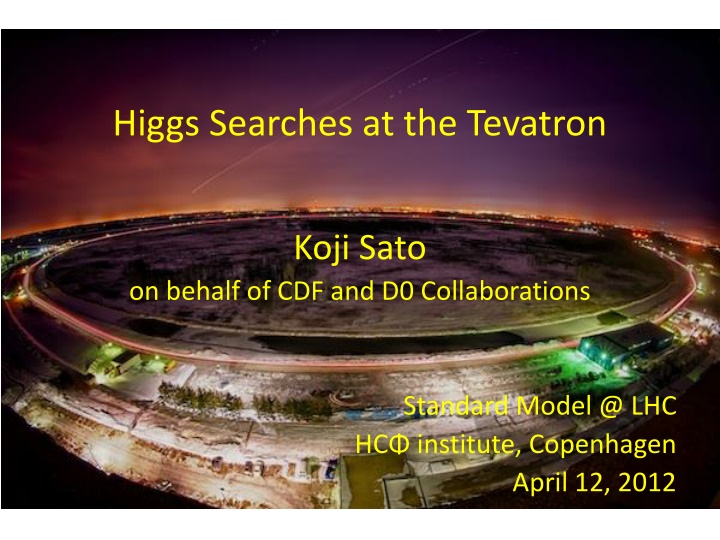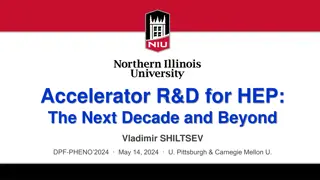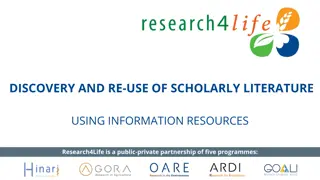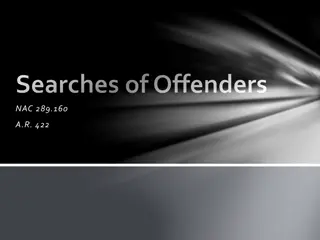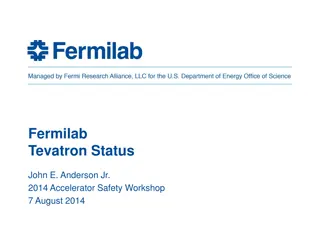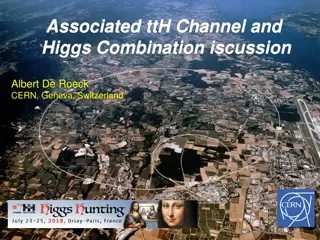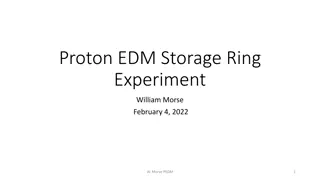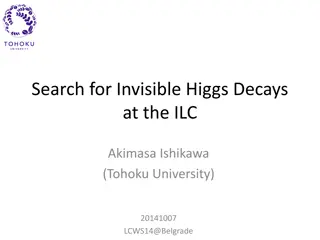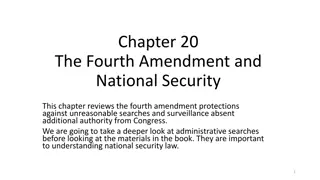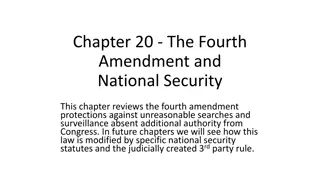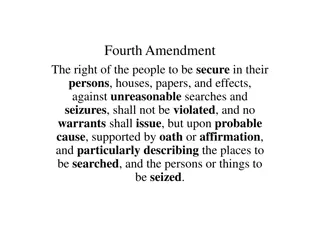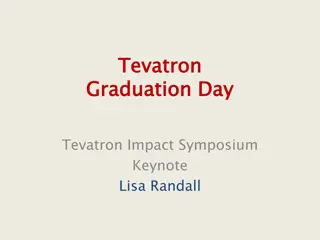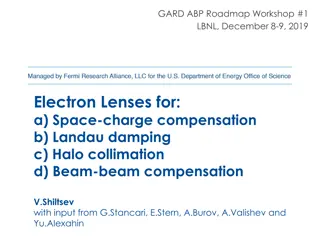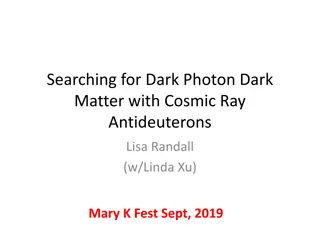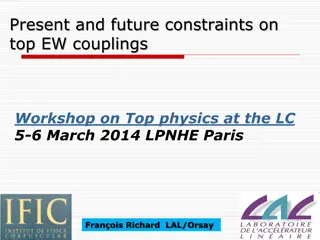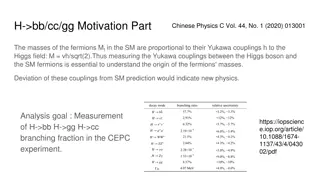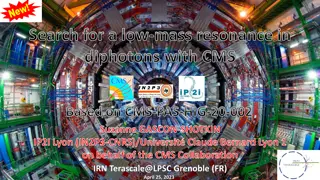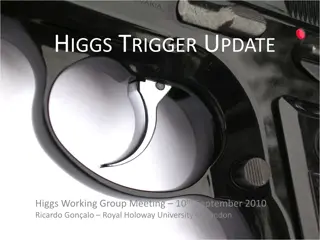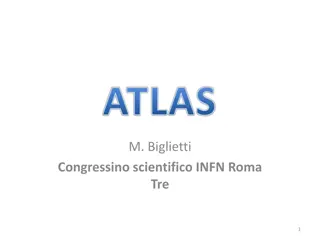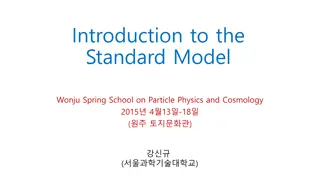Higgs Searches at the Tevatron
Delve into the exploration of Higgs boson searches and data analysis conducted at the Tevatron collider by the CDF and D0 collaborations, shedding light on crucial aspects such as collider runs, detector configurations, constraints on Higgs mass, and properties of the Standard Model Higgs. Discover the strategies employed, including the usage of multivariate algorithms and channel analyses, to enhance signal-to-background separation for a deeper understanding of particle physics phenomena.
Download Presentation

Please find below an Image/Link to download the presentation.
The content on the website is provided AS IS for your information and personal use only. It may not be sold, licensed, or shared on other websites without obtaining consent from the author.If you encounter any issues during the download, it is possible that the publisher has removed the file from their server.
You are allowed to download the files provided on this website for personal or commercial use, subject to the condition that they are used lawfully. All files are the property of their respective owners.
The content on the website is provided AS IS for your information and personal use only. It may not be sold, licensed, or shared on other websites without obtaining consent from the author.
E N D
Presentation Transcript
Higgs Searches at the Tevatron Koji Sato on behalf of CDF and D0 Collaborations Standard Model @ LHC HC institute, Copenhagen April 12, 2012
Tevatron Run II ? ? collisions at s = 1.96 TeV (1.8 TeV in Run I). Run II: Summer 2001 - Autumn 2011. Collisions at world highest energy until Nov 2009. Energy frontier for 25 years!! Two multi-purpose detectors (CDF and D0) for wide range of physics studies. Delivered: 12 fb-1. Recorded by CDF: 10 fb-1. Recorded by D0: 10 fb-1. 2
CDF and D0 Detectors Both are multipurpose detectors: Top/EWK measurements, Searches for Higgs and New Phenomena, and B physics. Precision tracking with Silicon in 1.5 (CDF)/1.8 T (D0) Solenoid field. EM/Had calorimeters for e/ /jet measurement. Outer muon chambers. D0 CDF 3
Constraint on Higgs Mass Mass of W Boson (World Average): Before Tevatron Run II mW=80.426 0.034 GeV/c2 With Tevatron Run II results mW=80.385 0.015 GeV/c2 Tevatron Run I result mtop= 178.0 4.3 GeV/c2 With Tevatron Run II results mtop= 173.2 0.9 GeV/c2 Mass of Top Quark (World Average): Before Tevatron Run II results (Spring 2004) mtop[GeV] Mhiggs< 152 GeV/c2 95% CL) . .was Mhiggs< 251 GeV/c2(95% CL) in Spring 2004. 4
SM Higgs Properties at Tevatron bb WW mH<135 GeV (low mass): gg H bb is difficult to see. Look for WH/ZH with leptonic vector boson decays. mH>135 GeV (high mass): Easiest to look for H WW l l . 5
CDF and D0 analyses Channel CDF Luminosity fb-1 D0 Lumiosity fb-1 ?? ???? 9.45 9.7 Z? ???? 9.45 9.7 Z? ???? 9.45 9.5 8.3 4.3-6.2 ? ?? 6.2 7.0 ?? ???? / ?? ???? ? ?? 10.0 9.7 ?? ???? 9.45 ??? ?????? 9.45 ? ?? ???? 9.7 8.6-9.7 ? ?? ???? 9.7 7.3 ?? ??? ??? + ? ?? ??? ? ? + ? 9.7 9.7 9.7 9.7 ? ?? ???? 9.7 ? ?? ???? 6 5.4
General Strategy Utilize Multivariate Algorithms (MVA) for better S/B separation. Neural Net, Boosted Decision Tree, Matrix Element, etc. Some analyses use MVA output into another MVA. The main channels analyzed the full dataset in Winter 2012. Analysis of events through different triggers. Improved b-jet energy scale measurement (low mass analyses) b-jet energy correction based on NN at CDF. Improved b-tagging (low mass analyses) Algorithms based on MVA. Divide analysis sample into high/low purity subsamples. Subdivision due to lepton and b-tag quality. 7
Jet Improved b-tagging Displaced Tracks CDF and D0 combine information of secondary vertex and tracks within jet cone by MVA (NN and BDT). Secondary Vertex Primary Vertex Light Flavor Eff. HOBIT Eff. SecVtx Eff. (old tagger) Light Flavor Eff. Lb Eff. 0.5% 50% 1% 54% 39% 4.5% 70% 8 2% 59% 47%
CDF: ?? ?+??? Channel (1) Event Selection: ?+? or ?+? pair within Z mass window. 2 or 3 jets with 1 or 2 b-tagged (4 tag categories). Train NN for different background. Z+qq - like WZ, ZZ - like other ZH - like tt-like other 9
CDF: ?? ?+??? Channel (2) Final Discriminant = separate Signal from all Bkgd. 10
CDF: ?? ?+??? Channel (3) WZ, ZZ Z+ qq ZH tt 11
CDF: ?? ?+??? Channel (4) Limit for ??= 125 GeV/c2: Exp: 3.6 ??? Obs: 7.2 ??? 12
D0: ? ?+? ?+?+ ??? Channel (1) Event Selection: ?+? , ?+? or ? ? pair within ???> 15 GeV. BDT to reject ?/? ?? in ?+? , ?+? events. Cut on ??(?,???) to reject ?/? and multijet for ? ? events. Analyze 0, 1, 2 jet bins. Train a final BDT discriminant against all background. ?? ?,??,??,??? are considered as signal. Different composition of signal and background in different jet multiplicity. 13
D0: ? ?+? ?+?+ ??? Channel (2) Distributions of the Final discriminant: 0 jet 2 jet 1 jet 14
D0: ? ?+? ?+?+ ??? Channel (3) ?+? , ?+? ,? ? channels combined: Limit for ??= 125 GeV/c2: Exp: 3.14 ??? Obs: 3.50 ??? Competitive with each individual ? ?? channel. 15
CDF and D0: Combined Limit http://www-cdf.fnal.gov/physics/new/hdg/Results_files/results/cdfcomb_mar2012/figures/cdf27febsmlimits100.jpg CDF excludes (95% C.L.): 148.8 < mH< 175.2 GeV/c2 D0 excludes (95% C.L.): 159 < mH< 166 GeV/c2 16
CDF+D0 Combined Limit What s this excess? Expected exclusion: 100<mH<119, 141<mH< 184 GeV/c2 Observed exclusion: 100<mH<106, 147<mH< 179 GeV/c2 17
History of Analysis Improvement Tevatron analyses have been constantly improved. Improvement far better than by the increase of dataset!! http://www-cdf.fnal.gov/physics/new/hdg/Results_files/results/cdfcomb_mar2012/figures/twotimescdf115feb2012log.jpg http://www-cdf.fnal.gov/physics/new/hdg/Results_files/results/cdfcomb_mar2012/figures/twotimescdf160feb2012log.jpg 18
Distribution of the Candidate Events Candidate events in the combined 16 analyses (~90 orthogonal subchannels): Data - Background 19
Signal Cross Section Best Fit Assuming the SM Higgs branching ratio. If real, excess around 115-135 GeV is consistent with the Standard Model. 21
Summary of Significance Excess Region Local significance Global significance 120-135 GeV/c2 CDF ? ?? 2.9? 2.7? 120-125 GeV/c2 D0 ? ?? ~1? 120-135 GeV/c2 Tevatron ? ?? 2.8? 2.6? CDF ? ?? <1? - 130-140 GeV/c2 D0 ? ?? 1.5? 130-140 GeV/c2 Tevatron ? ?? ~1? 120 GeV/c2 2.6? 2.1? CDF all chan. 130-135 GeV/c2 2.1? 1.5? D0 all chan. 120-135 GeV/c2 2.7? 2.2? Tevatron all chan. ? ?? mode drives the Tevatron searches around ?? ??? GeV/c2. Complementary to LHC. LHC searches are dominated by ? ??,??,??. 22
Summary Both CDF and D0 updated the main analysis channels with full dataset in Winter 2012. Tevatron combination now excludes: 100<mH<106, 147<mH< 179 GeV/c2 (Expected exclusion: 100<mH<119, 141<mH< 184 GeV/c2) Excess in 110<mH<140 GeV/c2region. Global significance of 2.2 with all analyses combined. Global significance of 2.6 with ? ?? analyses. Summer 2012 combination will include: D0: improvement on b-tag, b-jet energy scale and MVA techniques in the main channels. CDF: ZH MET+bb will update with improved b-tag. Updates from other channels as well. 23
BACKUP 24
Constraints on Higgs Mass (1) Tevatron Run I result Mass of Top Quark (World Average): Mass of W Boson (World Average): Before Tevatron Run II mW=80.426 0.034 GeV/c2 With Tevatron Run II results mW=80.385 0.015 GeV/c2 mtop= 178.0 4.3 GeV/c2 With Tevatron Run II results mtop= 173.2 0.9 GeV/c2 1/5 25
Constraint on Higgs Mass (2) Spring 2004 Mhiggs< 152 GeV/c2 95% CL) . .was Mhiggs< 251 GeV/c2(95% CL) in Spring 2004. 26
Sensitivity of Analysis Channels (CDF) http://www-cdf.fnal.gov/physics/new/hdg/Results_files/results/cdfcomb_mar2012/figures/cdfcollectedlimits_winter2012.jpg 28
Neural Net b-jet energy correction (CDF) A neural net was trained using b-jets in ? ?? Monte Carlo events to return a scale factor for jet energy. 29
CDF: ZHllbb Electron channels Here we observe a significant change Summer 2011 Winter 2012 30
CDF: ZHllbb Examine top 20 events in both channels based on S/B of the discriminant bin in which it s located The electron channel contains 12 new candidates within this high score region, while muon channel has 5 31
CDF: ZHllbb To study the effect of high S/B events on our observed limits, we remove our best new and best two new events from the e+e- channel and re-run the limits Gives one sigma level changes in the limits at 120 GeV/c2 32
LLR of Tevatron Combination ??? = 2??? ????;? + ? ?(????;?) 34
Tevatron: Signal Injection Study With 125 GeV signal, we expect a broad excess over the entire mass region. Consistent with SM signal plus background hypothesis over Higgs mass range from 110 to 140 GeV/c2 35
? ?? Channel by Channel (CDF,D0) http://www-cdf.fnal.gov/physics/new/hdg/Results_files/results/whlnubb_120307/plots/gif/unblind_Limit__JV_WH_AllJETWM_3k_120223_JESQ2_ALL_AllHobit.gif http://www-cdf.fnal.gov/physics/new/hdg/Results_files/results/vhmetbb_120302/plots/VHLimit_Moriond2012.png 36
By Decay Mode (CDF, D0) http://www-cdf.fnal.gov/physics/new/hdg/Results_files/results/cdfcomb_mar2012/figures/cdfbblimits28feb.jpg http://www-cdf.fnal.gov/physics/new/hdg/Results_files/results/cdfcomb_mar2012/figures/cdfwwlimits28feb.jpg 37
CDF H->WW OS channels Channels with oppositely charged dileptons. 0jet: 1jet 2jet 38
CDF Hbb Signal Injection study Because our neural network discriminants are optimized for separation of signal and background rather than mass reconstruction, we expect to observe (in the presence signal) higher than expected observed limits over a broad mass range . http://www-cdf.fnal.gov/physics/new/hdg/Results_files/results/cdfcomb_mar2012/figures/cdfbblimits28feb.jpg 40
CDF combination plots http://www-cdf.fnal.gov/physics/new/hdg/Results_files/results/cdfcomb_mar2012/figures/lnsbcdf125-1.jpg http://www-cdf.fnal.gov/physics/new/hdg/Results_files/results/cdfcomb_mar2012/figures/clb-cdf.jpg http://www-cdf.fnal.gov/physics/new/hdg/Results_files/results/cdfcomb_mar2012/figures/cdfxs27feb.jpg http://www-cdf.fnal.gov/physics/new/hdg/Results_files/results/cdfcomb_mar2012/figures/cdf125bgsub.jpg 42
